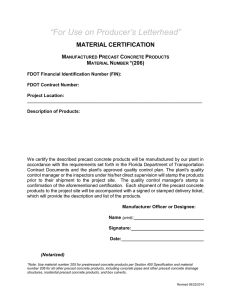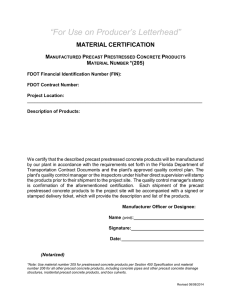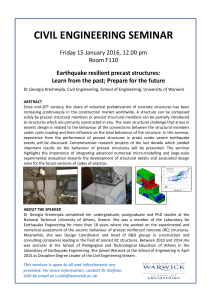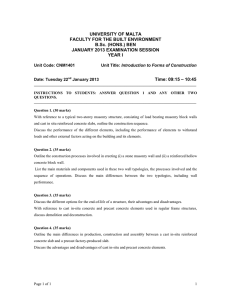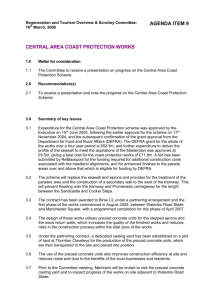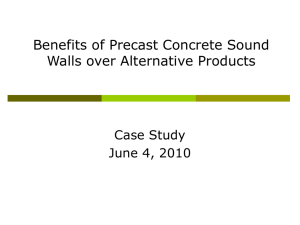life cycle assessment - Canadian Precast Prestressed Concrete
advertisement
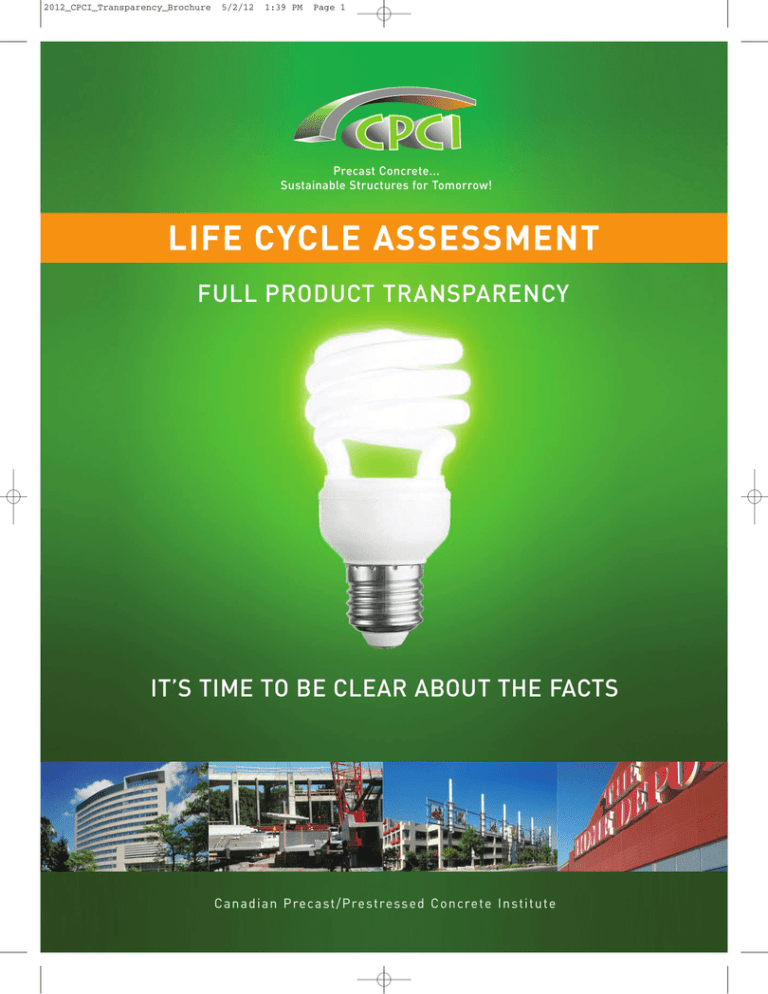
2012_CPCI_Transparency_Brochure 5/2/12 1:39 PM Page 1 Precast Concrete... Sustainable Structures for Tomorrow! LIFE CYCLE ASSESSMENT FULL PRODUCT TRANSPARENCY IT’S TIME TO BE CLEAR ABOUT THE FACTS C a n a d i a n P re ca st / P re st re ss e d C o n c re te I n st i t u te 2012_CPCI_Transparency_Brochure 5/2/12 1:39 PM Page 2 Full Product Transparency: It’s time to be clear about the facts Sustainability has entered the mainstream business agenda, and that’s good news, however, unsubstantiated marketing claims have come along with it - there is a need for clarity and scrutiny! As members of the Canadian Precast/Prestressed Concrete Institute (CPCI) we’ve always been honest and open about our own environmental performance. We think it’s fair to expect the same from everyone. To help people navigate through all the noise and assist our customers in making informed fact-based decisions, we are committed to full transparency at the product and system level. SCRUTINIZING EVERY PHASE OF THE LIFE CYCLE In 2008, the CPCI commissioned a life cycle assessment (LCA) to determine the environmental performance of our products. Our LCA studied the impacts throughout the life of a precast concrete structure – from extraction, production and transport of raw materials, through to the manufacturing and transport of the product to the project site, the assembly on site, customer use, occupancy, and maintenance of the structure and finally, the end of life reuse, removal or disposal of the product. In other words, it tells the entire story, revealing the environmental impacts at every phase. This clarifies where the biggest improvements can be made, and it prevents highlighting only the beneficial items. ENVIRONMENTAL DATA SHEET – A QUICK OVERVIEW CPCI members are moving towards product specific environmental data sheets (EDS). An EDS is a quick, fact-based overview of the main environmental impacts of a specific product. It highlights product features and services that help reduce the overall environmental impact. The data sheet lists how the product can help contribute to major green (and/or sustainable) building programs and gives details regarding third party verification of the environmental claims that have been made. ENVIRONMENTAL PRODUCT DECLARATIONS (EPD) CPCI members are progressing forward, and could be the first concrete manufacturers in North America to achieve a third-party-verified EPD, which provides comprehensive, uniform details about a product’s composition and overall environmental impact throughout its life cycle and gives stakeholders the tools they need to review and compare alternatives. We are committed to this level of detail and transparency and it is our aim to eventually have all CPCI member manufactured products covered by an EPD. 2012_CPCI_Transparency_Brochure 5/2/12 1:39 PM Page 3 Environmental Performance Based on Life Cycle Assessment (LCA) When defining which building product has the least environmental impact, the key is to determine which stages in the production, use and disposal of the product have the greatest environmental impacts and to focus on these. An LCA is the scientifically recognized way to assess the environmental performance of a product. It studies all the impacts throughout the life of a product: from extraction to production of raw materials, manufacturing, transport, assembly, use, maintenance and end of life. Life Cycle Assessment of Precast Concrete Commercial Buildings: Cradle-To-Grave GOAL AND SCOPE OF THE STUDY The goal of this project was to better understand the environmental life cycle performance of precast concrete in Canadian mid-rise precast concrete buildings relative to alternative structural and envelope systems. This was achieved by applying and following LCA standards, ISO 14040: 2006 and 14044:2006. Energy use of the buildings was included as more than 80% of the energy used over a building‘s life typically occurs during the use stage. Energy use in buildings is a function of climate, occupant load and behaviour, and environmental performance of the entire building. The reason for doing this study was to disseminate information on the Life Cycle Assessment of Precast Concrete. This information was based on the most complete and up-to-date life cycle inventory data for cement and concrete products. The intended audience is architectural, engineering, specifying professionals, building owners and developers, academics, governmental organizations, and other interested parties who require reliable information on sustainable building design practices. The scope of the LCA was defined by the function of a five-story commercial building, the functional unit, and the system boundaries including cut-off criteria and allocation rules. The full environmental impacts of each product are assessed, not only for the climate change impacts, but also the total embodied energy, and the eco-toxicity. VERIFICATION The study was conducted by The Athena Sustainable Materials Institute and is compliant to the ISO 14040:2006 Standard for Life Cycle Assessment. ISO 14040:2006 describes the principles and framework for life cycle assessment (LCA) including: a) Definition of the goal and scope of the LCA, b) The life cycle inventory analysis (LCI) phase, c) The life cycle impact assessment (LCIA) phase, d) The life cycle interpretation phase, reporting and critical review of the LCA, e) Limitations of the LCA, f) The relationship between the LCA phases, and g) Conditions for use of value choices and optional elements. 2012_CPCI_Transparency_Brochure 5/2/12 1:39 PM Page 4 LCA Precast Concrete Findings: • For a five-story commercial building in Toronto with cradle to grave boundaries: o 89% of the Global Warming Potential (GWP) is from operating energy o 9% of the energy use is embodied energy in materials o 2% of the energy is consumed in maintenance o A fraction of 1% is construction and end-of-life energy use • For a five-story commercial building in Vancouver with cradle to grave boundaries: o 50% of the Global Warming Potential is from operating energy o 38% represents embodied energy in the materials and systems o 11% is maintenance o A fraction of 1% is construction and end-of-life • Considering only operating energy in both Toronto and Vancouver, electricity use is responsible for the majority of impacts in most of the impact categories, including: global warming, acidification, respiratory effects, eutrophication, photochemical smog, solid waste, ozone depletion, and total primary energy; both fossil and non-renewable. • In Toronto, when comparing the buildings with precast structures using cradle-to-grave boundaries: o The buildings with the lowest GWP, are buildings with precast concrete envelopes o The precast buildings with the highest GWP are the buildings with curtain wall envelopes and the buildings with brick envelopes • More than half of the impacts in the following categories are due to operating energy: global warming, acidification, respiratory inorganics, water use, ozone depletion, total primary energy, non-renewable fossil fuel, and renewable energy from solar, wind, hydroelectric, and geothermal. • Excluding the impacts categories dominated by water use, for the precast concrete envelope with precast concrete structure in Toronto, when considering operating energy: o Lighting is responsible for almost 1/3 of impacts o Equipment (meaning office equipment and elevators) is responsible for slightly more than 1/3 of impacts o HVAC system (heating, cooling, fans, and pumps) is responsible for almost 1/3 of impacts • In Toronto and Vancouver, when comparing the precast structure buildings, o The buildings with the lowest total primary energy (TPE) are buildings with precast concrete envelopes o The buildings with the highest primary energy are the buildings with curtain wall envelope and the building with brick envelope • The life cycle environmental impacts of the precast products are driven by their cement content. For example, cement content is responsible for 63 to 66% of the total GWP and 42 to 43% of the TPE of precast concrete products. • Comparing a steel structure demonstrated the efficiency of the precast structure during occupancy. For any given envelope type, buildings with precast structures were shown to have lower GWP than buildings with steel structures during the occupancy stage, demonstrating that the effect of more thermal mass in the structure reduces the GWP. • During occupancy and operating stages, for a given envelope type, buildings with precast structures were shown to have lower TPE than buildings with steel structures. 1) Curtain Wall (CW-P), 2) Brick and Steel Stud (S-P), 3) Precast Concrete (P-P), 4) Insulated Precast Concrete (Pi-P), 5) Insulated Precast Concrete and Thin Brick Veneer (Pib-P) 2012_CPCI_Transparency_Brochure 5/2/12 1:39 PM Page 5 • The study modelled thermal performance of insulated precast wall panels according to minimum ASHRAE requirements, (Effective RSI of 2.66), HOWEVER higher insulation can be validated as typical construction for Toronto. A separate sensitivity analysis, with a 61% increase in overall effective wall RSI-value (Effective RSI of 4.29) for these scenarios results in: o 7% decrease in annual heating energy o 1% decrease in fan use o 2% decrease in annual energy use o 2% decrease in electricity use o 1-2% decrease in natural gas use o Conversely, a 61% increase in overall wall RSI-value does not affect cooling energy use, and nor does it affect interior loads (lights and equipment). • For the precast concrete envelope with precast concrete structure in Toronto, crushing concrete and recycling as aggregate versus demolishing and transporting to landfill reduces the GWP by approximately 220,000 kg CO2 eq. From the cradle-to-grave perspective, this represents a 1.4% reduction in GWP. What can your choice of a building product do for the environment? With more and more companies being conscious of the environmental impact of their operations, the answer could be... more than many of us initially thought! In the bigger picture of world environmental impact, the choice of construction building products may seem insignificant, but the choice of a building product is an environmental decision. The choice of a brand or a product will determine the resources used, pollution created, carbon dioxide emitted and waste generated - so the choice is about more than simply style, function and cost. Benefits of Modular Construction Precast concrete pioneered the concept of modular construction, which in itself offers greater flexibility and a number of sustainable benefits over site built systems: FAST CONSTRUCTION Developers who use total precast systems say precast can shorten the project timetable considerably when compared with steel or other building products and even more when compared with cast -in-place concrete construction. These savings can be critical in bringing a new building into a competitive marketplace or in meeting a tenant's need for occupancy on a specific date. SCHEDULING ADVANTAGES One-stop shopping with precast provides these advantages: 1) Sources much of the building shell and structure in one efficient, precast contract 2) Fabrication of precast elements during the permitting and/or site preparation stages saves time resulting in fast efficient construction regardless of weather conditions 3) Designing precast systems is made easier, thanks to assistance from CPCI member engineering departments 4) Precast components can be erected in winter conditions, maintaining tight schedules 2012_CPCI_Transparency_Brochure 5/2/12 1:39 PM Page 6 Looking for a building product with low environmental impact? There are many different issues to consider throughout the whole life of a precast concrete product from production to disposal. LIGHTER WEIGHT Providing the same performance and durability with less concrete or longer spans can substantially improve the structures environmental footprint. RECYCLED MATERIAL Using Supplementary Cementing Materials (SCM) reduces the quantity of cement required, corresponding to a less energy intensive product. MANUFACTURING EFFICIENCY Implementation of plant efficient processes and practices can reduce energy use, emissions, water consumption and waste generation. Use of renewable energy sources will further reduce the environmental impact. TRANSPORT SCM’S reduce the embodied energy of precast concrete products by substituting waste materials for cement. Manufacturing regionally instead of shipping products between continents is key to cutting transportation impacts. Smart logistics, higher efficiency vehicles can further reduce the overall impact. LESS INSTALLATION IMPACTS Minimizing on-site impacts - Constructing buildings through innovative solutions, such as just in time delivery of precast concrete, typically has less impact on the construction site and surrounding areas in addition to having less waste generated. DURABILITY A product that lasts for 60 – 100 years has approximately half the environmental impact of a product with a life span of thirty years. Using the right product for the job is key. Insulated wall panels being quality controlled manufactured on long line beds. LOW MAINTENANCE Precast concrete structures exteriors and interiors require less maintenance than buildings constructed using other materials. CHARGED THERMAL MASS The use of precast concrete as an innovative thermal energy storage system results in energy savings. Precast concrete has been used in the construction of net-zero buildings. END OF LIFE ALTERNATIVES Precast concrete offers a high-value end of life solution, such as disassembly, adaptability and reuse, which are better options than incineration or landfill. It can also be crushed and reused as aggregate in panels or for road base as a last resort. Precast panels being delivered just in time to the site. INDEPENDENT 3RD PARTY VERIFICATION The availability of 3rd party verification - based on life cycle assessments (LCA) – provide re-assurance about the accuracy and comparability of environmental product data. 2012_CPCI_Transparency_Brochure 5/2/12 1:39 PM Page 7 Let’s be up front: Why are the CPCI Members doing this? THE MARKET Consider the rapidly growing group of consumers looking to buy sustainable solutions. Many businesses are now looking to see how they can include this group in their target market by providing environmentally and/or socially superior products over their competitors. This can be seen in almost every industry. The Canadian Precast Industry has taken a stand - What’s good for the environment is also great for business - yours and ours. MONITORING The CPCI has officially launched the Sustainable Plant Program. The goal of this program is to reduce the environmental impact at the manufacturing level while creating a culture of sustainability within the industry. Our LCA has shown us where we, as an industry, can improve in our manufacturing stage of the life cycle. The benefits of sustainable business practices are well documented. As the leading technical resource for the precast concrete industry in Canada, the CPCI is providing the tools for its member plants to measure and implement improvements that will have a measurable impact on their environmental and economic performance using a web based Software Tracking Program. The results will be made public every three years through the Canadian Precast Concrete Sustainability Report. NEXT STEPS Environmental Product Declarations (EPDs) CPCI members are working to be the first concrete manufacturers in North America to achieve a thirdparty-verified EPD, providing comprehensive, uniform details about a product’s composition and environmental impact throughout its lifecycle. It will provide customers with the tools they require to review and compare alternatives. We are committed to this level of detail and transparency and aim to have all CPCI products covered by an EPD. Ask insightful questions before making a purchase. Expect transparency. Learn about our commitment to transparency through our Life Cycle Assessment of Precast Commercial Buildings. visit: sustainableprecast.ca 2012_CPCI_Transparency_Brochure 5/2/12 1:39 PM Page 8 LIFE CYCLE ASSESSMENT FULL PRODUCT TRANSPARENCY IT’S TIME TO BE CLEAR ABOUT THE FACTS For your copies of the Precast Concrete Environmental Data Summaries and the CPCI study Life Cycle Assessment of Precast Concrete Commercial Buildings contact CPCI at info@cpci.ca or (877) 937 2724 Precast Concrete... Sustainable Structures for Tomorrow!
